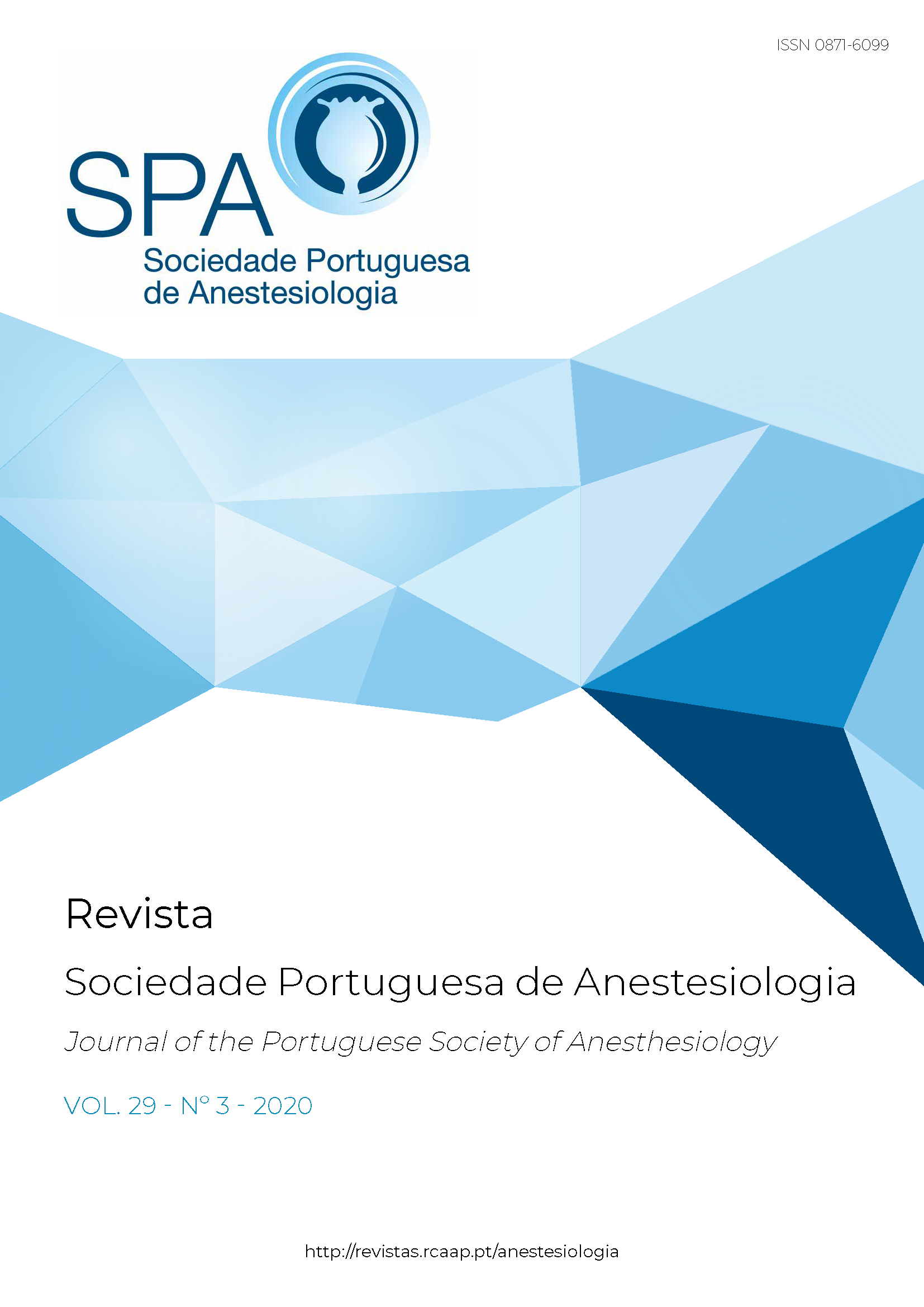Abordagem anestésica para cirurgia de Epilepsia: 4 anos de experiência do centro de referência no Hospital de Egas Moniz
DOI:
https://doi.org/10.25751/rspa.19958Palavras-chave:
Epilepsia, Anestesia Geral, Sedação Consciente, Cuidados Perioperatórios, NeurocirurgiaResumo
Introdução: Cerca de 30-40% dos casos de Epilepsia são refratários à terapêutica médica, sendo a cirurgia uma possibilidade de controlo sintomático, redução ou descontinuação da medicação anticonvulsivante e melhoria da qualidade de vida. A descrição da abordagem anestésica na literatura científica é rara embora apresente inúmeros desafios relativos ao doente, cirurgia, e cuidados perioperatórios. O objetivo deste estudo é a análise retrospetiva da abordagem anestésica para cirurgia de Epilepsia durante 4 anos no centro de referência do Hospital de Egas Moniz.
Material e Métodos: Revisão de registos médicos dos doentes submetidos a cirurgia de Epilepsia, entre janeiro de 2014 e dezembro de 2017. Foi colhida e analisada informação relativa a dados demográficos, avaliação e evolução perioperatória, seguimento e sucesso terapêutico.
Resultados: Foram submetidos a cirurgia de Epilepsia 68 doentes, com idade média de 37,7 anos, classificados ASA II (77,9%) e ASA III (22,1%). As técnicas escolhidas foram anestesia geral (95,6%) e sedação consciente (4,4%). Ocorreram como complicações intraoperatórias hemorragia significativa (4,4%), convulsões (2,9%) e bradicardia (2,9%). A permanência em Unidade de Cuidados Intensivos (63,2%) durou, em média, 1,6 dias, incluídos em 7,8 dias de internamento hospitalar. No seguimento em ambulatório, houve redução de 90% das convulsões e da medicação anticonvulsivante.
Discussão: O conhecimento e experiência na abordagem anestésica em cirurgia de Epilepsia são cruciais para tornar estes complexos procedimentos eficazes e seguros, diminuindo as complicações e melhorando a qualidade de vida.
Conclusões: A abordagem peri-operatória tailor-made a cada doente/cirurgia parece ser a chave do sucesso terapêutico e prognóstico.
Downloads
Referências
2. Pedroviejo V, Ayuso M, Jiménez A. Tratamiento anestésico del paciente adulto epiléptico no neuroquirúrgico. Rev Esp Anestesiol Reanim. 2009; 59(7): p. 425-435.
3. Pacreu S, Vilà E, Moltó L, Bande D, Rueda M, Fernández Candil JL. Manejo anestésico en la cirugía de epilepsia con electrocorticografía intraoperatoria. Rev Esp Anestesiol Reanim. 2018;65: p. 108-111
4. Bindra A, Chouhan RS, Prabhakar H, Chandra PS, Tripathi M. Perioperative anesthetic implications of epilepsy surgery. J Anesth. 2015; 29: p. 229–234.
5. Erickson K, Cole D. Anesthetic Considerations for Awake Craniotomy for Epilepsy and Functional Neurosurgery. Anesthesiol Clin. 2012; 30: p. 241-268.
6. Koh JL, Egan B, McGraw T. Pediatric epilepsy surgery: anesthetic considerations. Anesthesiol Clin. 2012; 30(2): p. 191–206.
7. Sanus GZ, Yuksel O, Tunali Y, Ozkara C, Yeni N, Ozlen F, et al. Surgical and anesthesiological considerations of awake craniotomy: Cerrahpasa experience. Turk Neurosurg. 2015; 25(2): p. 210-217.
8. Shetty A, Pardeshi S, Shah VM, Kulkarni A. Anesthesia considerations in epilepsy surgery. Int J Surg. 2016; (36): p. 454-459.
9. Hader W, Tellez-Zenteno J, Metcalfe A, Hernandez-Ronquillo L, Wiebe S, Su Kwon C, et al. Complications of epilepsy surgery: A systematic review of focal surgical resections and invasive EEG monitoring. Epilepsia. 2013; 54(5): p. 840-847.
10. Sokhal N, Rath GP, Chaturvedi A, Dash HH, Bithal PK, Chandra PS. Anaesthesia for awake craniotomy: A retrospective study of 54 cases. Indian J Anaesth. 2015; 59(5): p. 300-305.
11. Khanna P, Ray BR, Govindrajan SR. Anesthetic management of pediatric patients with Sturge–Weber. J Anesth. 2015; 29(6): p. 857-861
12. Iturri Clavero F, González Uriarte A, Tamayo Medel G, Pomposo Gaztelu IC, Cano Dorronsoro M, Martínez Ruiz A. Perioperative considerations in vagal nerve stimulator implantation. Rev Esp Anestesiol Reanim. 2010; 57(7): p. 431–438.
13. Kunieda T, Kikuchi T, Miyamoto S. Epilepsy surgery: surgical aspects. Curr Opin Anesthesiol. 2012; 25: p. 533-53.
14. Chui J, Venkatraghavan L, Manninen P. Presurgical Evaluation of Patients with Epilepsy: the role of the anesthesiologist. Anesth Analg. 2013; 116(4): p. 881–888.
15. Hader W, Tellez-Zenteno J, Metcalfe A, Hernandez-Ronquillo L, Wiebe S, Su Kwon C, et al. Complications of epilepsy surgery: A systematic review of focal surgical resections and invasive EEG monitoring. Epilepsia. 2013; 54(5): p. 840-847.
Downloads
Publicado
Como Citar
Edição
Secção
Licença
Os artigos estão livremente disponíveis para serem lidos, descarregados e partilhados a partir do momento da sua publicação.
A RSPA reserva-se o direito de comercialização do artigo enquanto parte integrante da revista (na elaboração de separatas, por exemplo). O autor deverá acompanhar a carta de submissão com a declaração de cedência de direitos de autor para fins comerciais.
Relativamente à utilização por terceiros a Revista da SPA rege-se pelos termos da licença Creative Commons “Atribuição – uso Não-Comercial (CC BY-NC).
Após publicação na RSPA, os autores ficam autorizados a disponibilizar os seus artigos em repositórios das suas instituições de origem, desde que mencionem sempre onde foram publicados.


